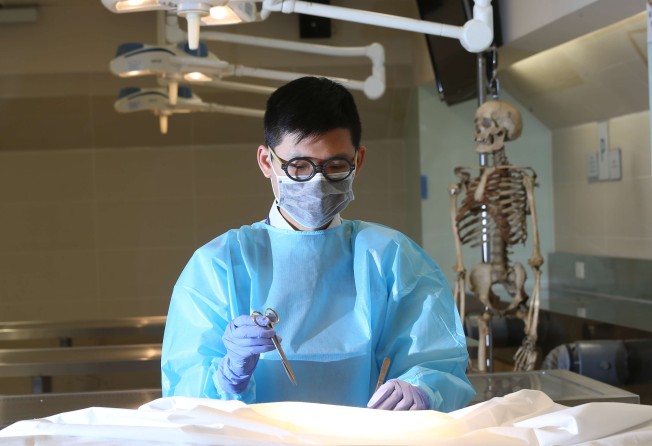
How Hong Kong embalmer’s graphic artist training helps him beautify bodies
Pasu Ng followed his family into the embalming trade and now handles cadavers used by student doctors at one of city’s universities, where he’s helped end dissection of unclaimed bodies

Pasu Ng Kwai-lun, 36, is a soft-spoken young man. Fashionably dressed, he fixes his funky glasses as he speaks passionately about his craft – preserving dead bodies.
Ng attended the Hong Kong Art School and Polytechnic University design school, and he started out as a freelance graphic designer before his family, questioning the industry’s stability, lured him into the family embalming business.
Only half convinced of the wisdom in such a drastic career change, Ng became a funeral-home apprentice to appease his parents. Today, he is in charge of the dissecting room at the Chinese University of Hong Kong’s (CUHK) medical school.
Death has always been a taboo in Chinese culture, but Ng says working around death isn’t as creepy as people would expect. “Being an embalmer and a make-up artist for the deceased was a relatively easy job,” he says. “You work a few hours a day, and you can do your own thing. Not to mention how good the money is.”
Finding the graphic design industry becoming ever more saturated, Ng began supporting himself solely through embalming in funeral homes.

He knew early on that he would need a more profound motivator than money if he were to excel at his job. Not long after he became an embalmer, one of his childhood friends committed suicide, and the friend’s family asked Ng to embalm the body.
It wasn’t an easy task, Ng says, but the loss helped him realise the importance of his job. He honoured his friend in the only way he knew how – by making sure that the body’s appearance reflected his friend as his family and loved ones remembered him.
The experience became a catalyst for Ng, spurring him to learn about counselling and death education. He joined volunteer groups and spent most of his free time doing youth leadership work at church.
In 2010, Ng came across an embalmer job at CUHK. “The salary was a lot lower than in the funeral-home business, but I thought it was an opportunity to learn different things and meet new people,” Ng says.
Ng noticed that CUHK had been using unclaimed bodies as cadavers, and that made him uncomfortable.There has to be a very sad reason why they were alone at the end of their lives,” he says. “Using their bodies after they leave the physical world, without them knowing, just seems a bit inhumane to me.”
In conjunction with the university, Ng started a programme in 2011 to encourage the public to donate their remains for medical education and training.
After years of concerted effort from Ng and his team, the programme has proved to be a success. CUHK hasn’t used any unclaimed bodies as cadavers since 2014. And more than 2,000 people register as “silent teachers”, or body donors, every year.
One of the many people who have signed up is 88-year-old Chung Yik-nung, who did so after reading about the programme in a newspaper. Supported by his family, and undeterred by cultural taboos, he says he thinks it would be great if his body could help someone after he leaves the physical world. “There’s nothing bad about donating bodies,” he says. “Whether it’s an organ or my whole body, they can use whatever is useful for other people.”
“The silent-teacher programme isn’t just about asking people to donate their bodies, it’s also about showing people that we, and our medical students, respect the dead,” Ng says.
A free ash-scattering ceremony in TseungKwan O Chinese Permanent Cemetery is offered to donors. And a permanent memorial wall has been erected in the cemetery to provide an alternative resting place for the so-called silent teachers, as well as a place for the families to pay their respects.

In March 2016, a third-year CUHK medical student took her own life. “It was a sad time for everyone in the department,” Ng says, recalling the morning he heard the news. “But it was also an opportunity to talk about death and honour life.”
He quickly set up a Let Us Share memorial page on Facebook for students to talk about their feelings and grieve in a safe space. He designed greeting cards with tips on how to be a good listener. To him, the tragedy further accented the need to overcome our taboos, and to encourage more open conversations about death, particularly in Hong Kong.
“Life education is about finding your identity and purpose in life,” Ng says. “On the other hand, death education is more about valuing your relationship with your loved ones when you are nearing the end of your life, and about appreciating life more in the context of our own mortality.”
He also wants people to know how helpful it can be to discus practical issues, such as advanced directives for health care – whereby a person indicates, while mentally competent, the type and extent of health care he or she would like to have in the event that he or she is no longer competent enough to make decisions. Having that predetermined guidance during the final moments of a loved one’s life could make the experience less painful.
For now, dividing his time between embalming bodies and giving seminars in schools and institutions, Ng is happy on the path he’s set, and he’s pleased with the progress made in the silent-teachers programme. But he knows there is still much work to do.